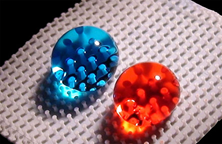Superamphiphobic Paper with Potential Microfluidic Applications Developed by Georgia Tech

Georgia Tech has developed a new paper that repels fluids. The new superamphiphobic paper is developed by modifying the underlying network of cellulose fibers, etching off surface fluff and by applying a thin coat of chemicals on its surface.
The researchers at Georgia Tech’s School of Chemical and Biomolecular Engineering have exploited the “lotus effect” exhibited by leaves of lotus plants due to complex micro and nanoscopic structures on its surface to minimize adhesion in the development of superamphiphobic paper. They have created an advanced material out of good old fashioned paper by modifying the production process to improve its properties.
Both hardwood and softwood can be used to manufacture the new paper by using the modified process to impart the superhydrophobic and superoleophobic properties.
In this modified process, cellulose fibers are first ground to smaller structures, pressed and then treated with butanol after removing water in order to prevent hydrogen bonding between them and to control their geometry. The amorphous fluffy cellulose layer is then removed using oxygen plasma etching process to expose crystalline nanofibrils, creating a second level of roughness with proper geometry needed for repelling liquids. The process is then followed by application of a fluoropolymer coat on the network of cellulose fibers.
The superamphiphobic paper opens a whole new avenue for developing newer generation of biomedical diagnostics and it also provides a cheaper alternative for water proof and oil proof packaging materials. This paper can be used for creating microfluidic devices by printing channels with a special hydrophobic ink on them. These microfluidic devices can then be used to develop inexpensive biomedical diagnostic tests. Until now superamphiphobic surfaces are created over rigid and brittle surfaces using lithographic techniques, and this new paper offers a more flexible, cheaper and a sustainable alternative. The studies conducted on the new superamphiphobic paper have shown promising results so far, and it is possible that this paper will see wide spread usage for numerous applications in the near future.
Source: Georgia Tech
Details are published online in the journal ACS Applied Materials & Interfaces.

